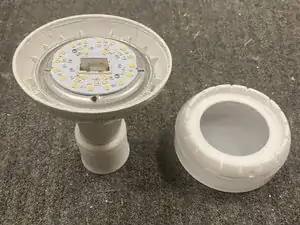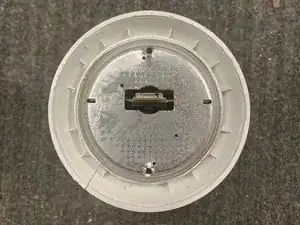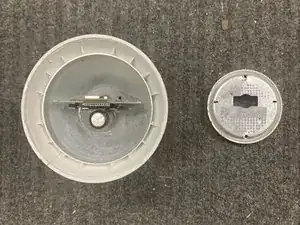Introduction
One of my LIFX BR30 smart lightbulbs lost the ability to show white light, it always seems to have a blue hue to it. Resetting the software and no effect and the rest of our bulbs have worked well. The bulb is now 5 years old and beyond its 2-year warranty.
Hoping to be able to view the PCB for an issue, I decided to take the light bulb apart, pictures and instructions for disassembly follow.
Tools
Parts
-
-
The diffuser is held onto the bulb's base by four snap-lock plastic tabs, which also have a dab of silicone adhesive on them to prevent the diffuser from rattling.
-
The tabs are just to the right of the small Phillips-head screws you can see in the small space between the diffuser and base.
-
Insert a strong chisel or similar prying tool to bend the plastic tabs. You'll need to bend at least two at once, and then insert something to hold open the one side while you work on the other.
-
After removing the diffuser, remove the rubber white silicone gasket (photos two and three) and set aside.
-
-
-
Removing the diffuser exposes the LED PCB. The edge of the WiFi board can also be seen with the antenna protruding.
-
Note the silicone adhesive on the tabs. You probably don't need to replace this with fresh adhesive, but if you do, make sure it's rated for high temperatures.
-
On the LED PCB, you can see the white and colored LEDs. The PCB is a thermally-conductive aluminum material.
-
Around the edge of the bulb's case there is a plastic retaining ring attached by four Phillips-head screws. It's not necessary to remove this for further disassembly.
-
The LED PCB has a pin header that connects down into the WiFi board. A thermal adhesive pad holds the PCB to the metal bulb case. You can gently pry around the edge of the PCB until the adhesive releases, and the connector separates.
-
On my bulb, the PCB was not fully-seated on the thermal pad, potentially causing heat-related intermittent faults.
-
-
-
The gray material that is solidified around the PCB tears away quite easily, but I stopped here as my light still half-works and I didn't want to risk damaging it further. When we procure more courage, I'll return here to discuss how we removed the gray material that coats the board and steel sidewalls of the PCB's cage.
-






